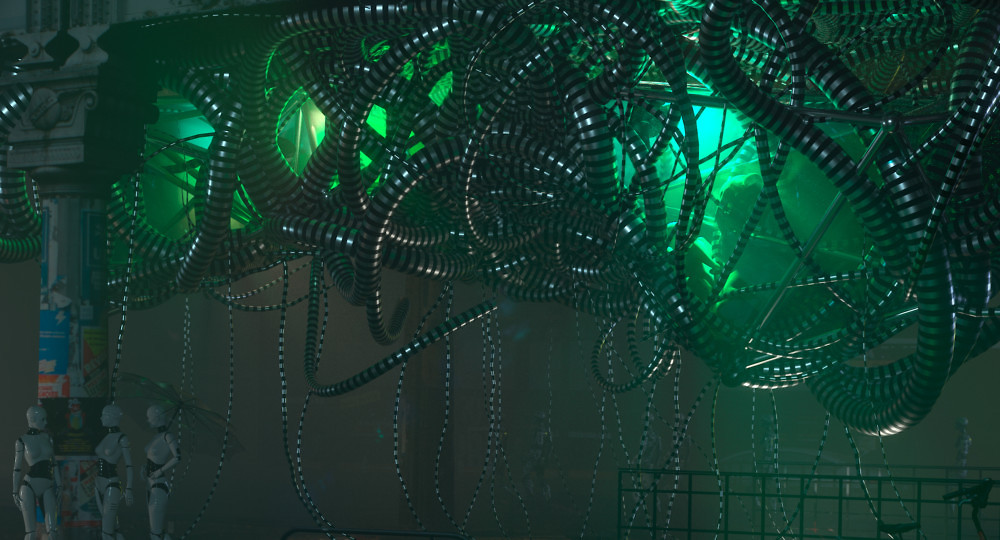Climax Paris 2017, Maison de l’architecture Ile-de-France. Nominé.
L’Autre Ligne est une fiction. Ian Kame Taverner dérive dans les rues de Paris qui a atteint son climax. Alors qu’il suit la ligne 2 du métromatique aérien entre les stations Jaurès et Stalingrad, il y découvre suspendues à ses poutres métalliques d’étranges structures molles en formation.
Minuit venait de passer, mais l’air ambiant était encore lourd et chaud. Défilant sur ses rétines électro-sensibles, les algorithmes prédicateurs n’arrêtaient pas de soumettre son cerveau artificiel à de nouvelles données ; mais aucune ne voulait changer le cours des choses. Cela faisait maintenant plus d’une semaine que Ian n’était pas sorti de chez lui — même depuis l’intérieur cartographié de son sommeil hypodermique. L’atmosphère rafraichie de son appartement n° XB15 était devenue un véritable dopant anxiogène. Mais cette nuit-là, il en avait envie, il irait déambuler dans les rues noires à la dérive.
Son errance le conduisit vers la ligne. Cette ligne de métal qui supportait toujours le métromatique. Il aimait cette frontière invisible qu’il suffisait de suivre pour imaginer ce qui avait été autrefois une des limites de la capitale. Elle n’était plus maintenant qu’une étendue informe aux lumières indéfinies.
Paris avait pourtant évolué, on avait tenté de le transformer à des fins résilientes. La ville faisait de son mieux pour répondre aux contraintes d’un futur qui s’éternisait dans un présent à perpétuité dans lequel zonaient des corps schizophrènes et dégénérés par l’horloge atomique.
Sa vision était troublée. Ian ne savait pas si c’était parce que le taux d’humidité indiqué sur ses capteurs était élevé, mais il se sentait pris dans un bouillonnement d’images étranges. Il suivait toujours la ligne dont les dessous par endroits se déformaient comme si une maladie apparaissait — la ville ne supportait plus son climax bio-technologique. La vie avait pourtant su résister, mais l’offre éco-industrieuse n’avait pas répondu à la demande de manière équitable.
Les prothèses qui devaient maintenir un état urbain stable mutaient. Les cerveaux botoxés des survivants avaient donné naissance à un alien urbain métastasé. Des bubons luminescents et suants la vermine technique apparaissaient là où la ville pouvait encore les accueillir.
–
The Other Line is a fiction. Ian Kame Taverner drifts through the streets of Paris, which has reached its climax. As he follows Line 2 of the aerial Metromatic between the Jaurès and Stalingrad stations, he discovers strange soft structures suspended from its metal beams.
It was past midnight, but the surrounding air was still hot and heavy. Scrolling through his electro-sensitive retinas, the predictive algorithms never stopped subjecting his artificial brain to new data—but none of them wanted to change the course of things. It had now been over a week since Ian didn’t leave home—even since the mapped interior of his hypodermic sleep. The cooled atmosphere of his apartment had become a real anxiogen drug. This night, because he wanted to, he would stroll along the dark streets adrift.
His wandering led him toward the line, this metal line that had always supported the Metromatic. He liked this invisible border, he only needed to follow to imagine what had once been one of the boundaries of the capital. It was now nothing more than a shapeless expanse of undefined lights.
Nevertheless, Paris had evolved; and attempts had been made to transform it for resilient purposes. The city was doing its best to meet the constraints of a future that dragged on in a perpetual present, in which schizophrenic bodies wandered aimlessly, degenerated by the atomic clock.
His vision was clouded. Ian didn’t know if it was because the humidity readings on his sensors were high, but he felt caught in a web of strange images. He was still following the line, whose undersides were twisting in places as if a disease was emerging—the city was no longer supporting its biotechnological climax. Life had been able to resist, but the eco-industrial supply had not equitably met the demand.
The prostheses that had to preserve a stable urban state were mutating. The botoxed brains of the survivors had given birth to a metastasized urban alien. Luminescent buboes sweating the technical vermin appeared there, where the city could still host them.




